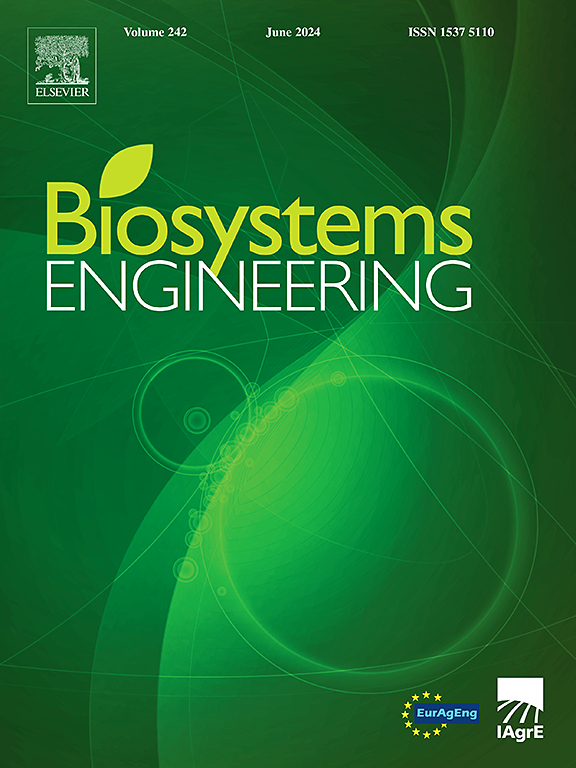Design and test of a rotary centrifugal granular fertiliser hole-applied discharge device
IF 5.3
1区 农林科学
Q1 AGRICULTURAL ENGINEERING
引用次数: 0
Abstract
To solve the issues of inadequate loading and hole formation performance of the fertiliser hole-applied discharge device, a rotary centrifugal granular fertiliser hole-applied discharge device (RCGF-HDD) was proposed, and the key components were designed through theoretical analysis. The discrete element method was used to simulate the characteristics of loading and hole formation. Bench tests were designed to validate the simulation results and to explore the adaptability of the discharge device to various types of fertiliser. Through response surface analysis, the loading and hole formation performance were found to be optimal at a fertiliser cavity depth of 21.6 mm, a forward speed of 3.6 km h−1, and a fertiliser dosage per hole of 5.3 g, resulting in average hole length, coefficient of variation of hole length, and error in fertiliser dosage per hole of 72.4 mm, 8.91 %, and 1.24 %, respectively. The results of the bench test showed that under the optimal parameter combination, the average fertiliser cluster length was 22.2 mm, the coefficient of variation was 7.88 %, and the error in fertiliser dosage per hole was 5.86 %. At forward speeds of 8–12 km h−1, the average fertiliser cluster length was lower than 50.0 mm, which indicated that the RCGF-HDD had a certain degree of adaptability and good fertiliser agglomeration properties. The innovative RCGF-HDD developed can meet the demand, and the research methods and results can serve as references for the design and optimisation of fertiliser hole-applied discharge devices.
旋转离心式颗粒肥料穴施排放装置的设计与试验
为解决肥料穴施排放装置装载和成孔性能不足的问题,提出了一种旋转离心式颗粒肥料穴施排放装置(RCGF-HDD),并通过理论分析对其关键部件进行了设计。采用离散元法模拟了加载和成孔的特征。设计了台架试验来验证模拟结果,并探索排肥装置对各种肥料的适应性。通过响应面分析,发现在肥料空腔深度为 21.6 毫米、前进速度为 3.6 千米/小时、每孔肥料用量为 5.3 克时,装载和成孔性能最佳,平均孔长、孔长变异系数和每孔肥料用量误差分别为 72.4 毫米、8.91 % 和 1.24 %。台架试验结果表明,在最佳参数组合下,平均肥料团长度为 22.2 毫米,变异系数为 7.88 %,每孔肥料用量误差为 5.86 %。在前进速度为 8-12 km h-1 时,平均肥料团长度低于 50.0 mm,这表明 RCGF-HDD 具有一定的适应性和良好的肥料团聚性能。开发的创新型 RCGF-HDD 可满足需求,其研究方法和结果可为肥料穴施排放装置的设计和优化提供参考。
本文章由计算机程序翻译,如有差异,请以英文原文为准。
求助全文
约1分钟内获得全文
求助全文
来源期刊

Biosystems Engineering
农林科学-农业工程
CiteScore
10.60
自引率
7.80%
发文量
239
审稿时长
53 days
期刊介绍:
Biosystems Engineering publishes research in engineering and the physical sciences that represent advances in understanding or modelling of the performance of biological systems for sustainable developments in land use and the environment, agriculture and amenity, bioproduction processes and the food chain. The subject matter of the journal reflects the wide range and interdisciplinary nature of research in engineering for biological systems.
 求助内容:
求助内容: 应助结果提醒方式:
应助结果提醒方式:


